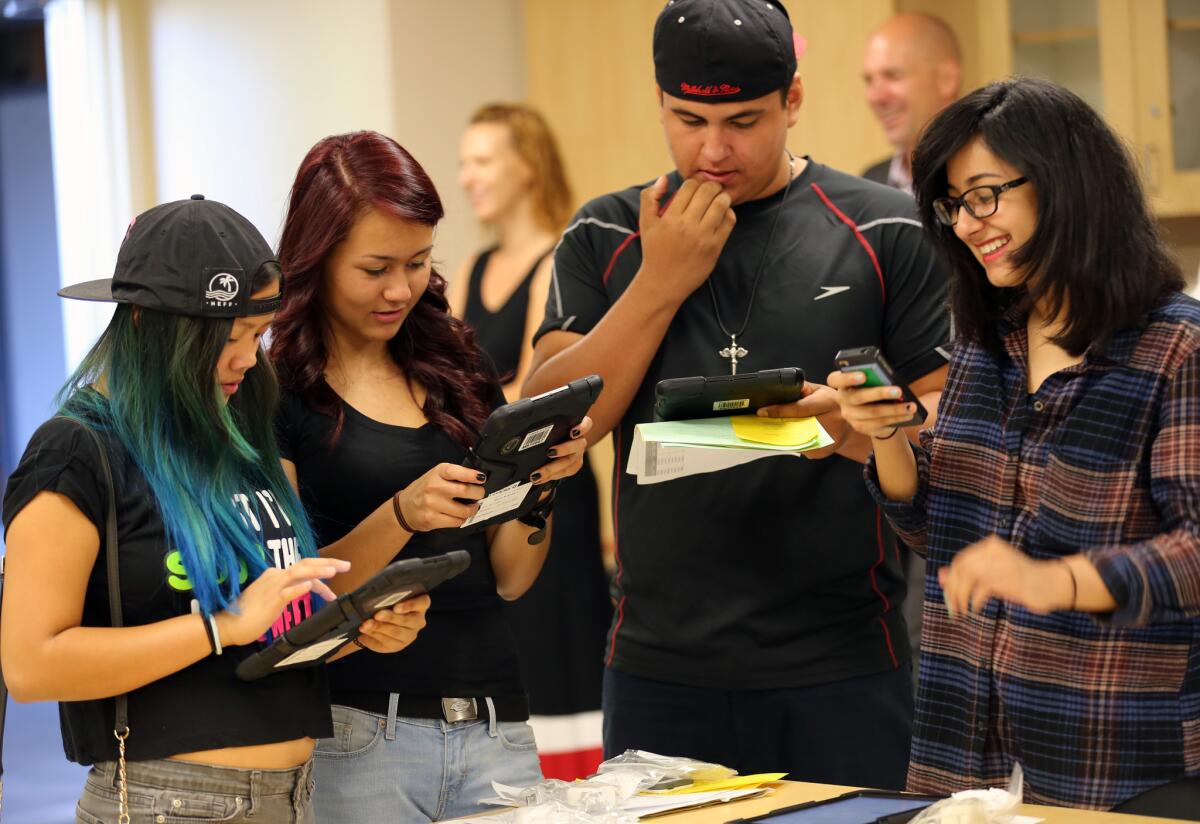New report finds ongoing iPad and technology problems at L.A. Unified

Valley Academy of Arts and Sciences students, from left, Jordann Ventura, 14, Karyna Mills, 15, Guillermo Romero, 15, and Dayanara Trujillo, 15, receive iPads before the start of the school year.
- Share via
Had things gone according to plan, every public school student in Los Angeles would be working on his or her own iPad by now and textbooks would be largely a thing of the past.
What ensued instead was a costly debacle, and, in its wake, a fledgling, problematic recovery, described in a new report released Wednesday.
The analysis shows that serious challenges have persisted with technology in the L.A. Unified School District, including limited classroom use of iPads and other computers, inadequate support for teachers and partial or inconsistent access to the Internet.
The researchers also found limited use of online curriculum provided by Pearson, for which the district purchased a three-year license, at the added cost of about $200 per device.
The results were sobering but not altogether surprising. District officials have acknowledged difficulties with technology. The school system abandoned a $1.3-billion effort to provide an iPad to every student, teacher and campus administrator as too expensive and unsustainable. And Supt. Ramon C. Cortines has characterized the district as lacking an instructional plan for the use of technology.
Cortines took over last October, after former Supt. John Deasy resigned under pressure. The iPad effort had been a signature initiative of Deasy’s, but he, too, had accepted a scaled-back program by the time he left.
On Wednesday, officials said measures to respond to the latest findings were well underway. That’s also what they said last year after the same researchers raised similar issues in their initial report.
But the district also offered evidence of progress. For example, the report, based on a review completed several months ago, estimated that 40% of elementary schools, more than 200, still lacked adequate wireless Internet service.
As of this week, the number of schools with substandard Wi-Fi stood at 19, said Bill Wherritt, a deputy facilities director. Work on those should be completed by early next year, he added.
The review was conducted by Washington, D.C.-based American Institutes for Research, which the school system hired at a cost of $340,000 to conduct the evaluation.
Although there have been steps forward, “the district has not yet arrived at a solution for several organizational and technical challenges,” the researchers concluded. “Ongoing challenges and areas where less progress occurred included: deploying devices in a timely manner, communicating with schools, coordinating efforts with other instructional initiatives and clarifying a vision for technology use in instruction.”
On the plus side, the district has developed a procedure to make sure schools are ready to make good use of computers. But so far, only one school, Valley Academy of Arts and Sciences in Granada Hills, has satisfied this requirement and distributed iPads. Five others are close, about a week away, said Sophia Mendoza, interim director for instructional technology.
Last year, some schools were not able to hand out devices until February.
The district also has developed more training for schools and provided more technical support.
Initially, all schools were supposed to send the iPads home, but that ended after students quickly figured out how to delete security filters intended to limit Internet browsing.
The Internet filter is stronger now, and teachers have used “digital citizenship” units to encourage responsible computer use; 26 schools sent iPads home with students last year and reported no major problems.
The district has enough computers for every student at about 100 schools, in a district with about 1,000 campuses.
Under the initial plan, all teachers were expected to shift to Pearson online curriculum. Instead, the district has demanded a refund for the curriculum from Apple, for whom Pearson was a subcontractor.
Few teachers took advantage of the Pearson materials, according to the report.
The Pearson content was used mostly for elementary math instruction; those teachers already were familiar with Pearson math textbooks at those grade levels. The researchers found no use of the curriculum in a sample of middle and high school classrooms.
This year, the district bought new math textbooks, using publishers other than Pearson. All the new texts include an online version.
Pearson has consistently defended the quality of its materials, noting that other districts have continued to use both traditional and online products.
The awarding of the Apple/Pearson contract became the subject of an ongoing FBI investigation last year. Current and former district officials have denied any wrongdoing.
The district has not set aside money for any further independent review.
Twitter: @howardblume
ALSO
State regulator orders detailed inspection of Long Beach power grid
Kardashian fireworks scare sparks ‘corrective action plan’ from fire chief
Six soccer players charged with rowdiness, ordered not to drink or fly Southwest
More to Read
Sign up for Essential California
The most important California stories and recommendations in your inbox every morning.
You may occasionally receive promotional content from the Los Angeles Times.











